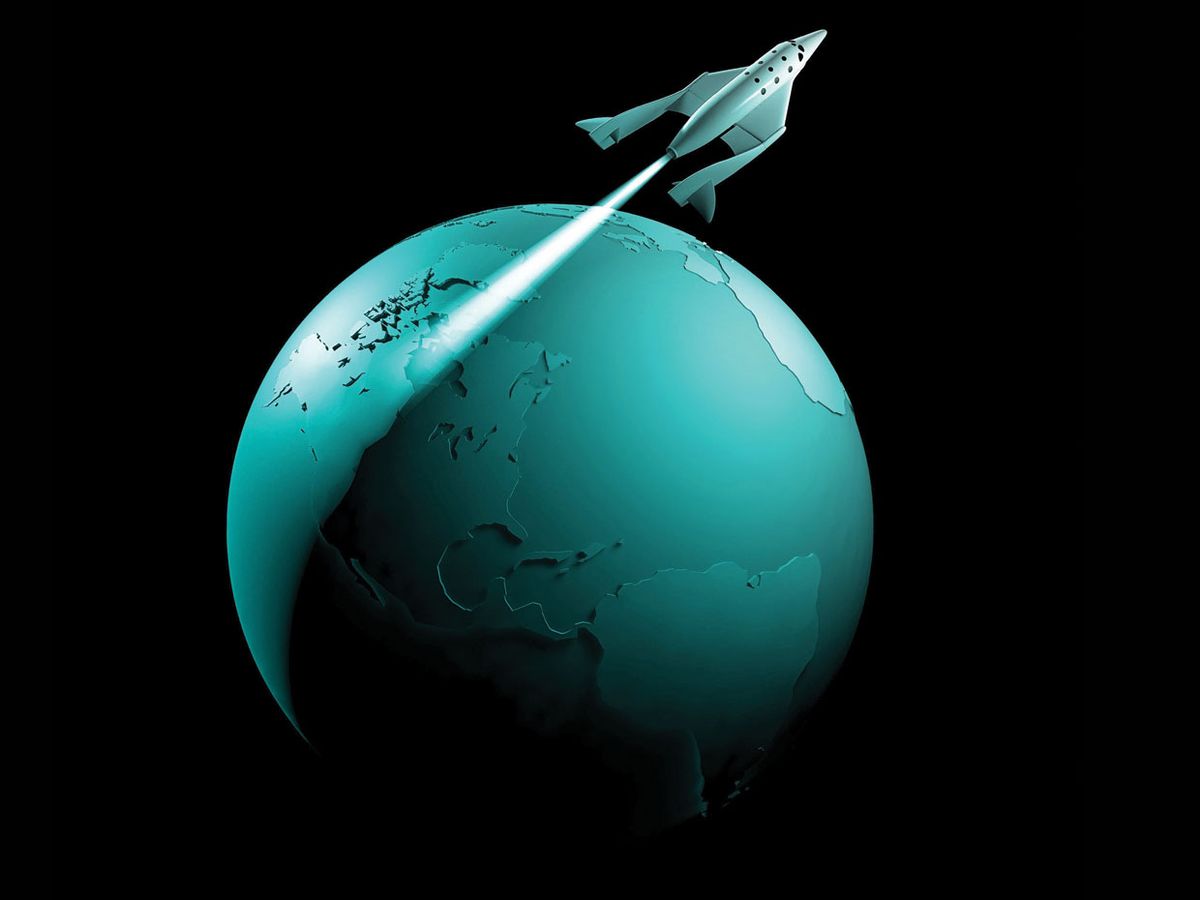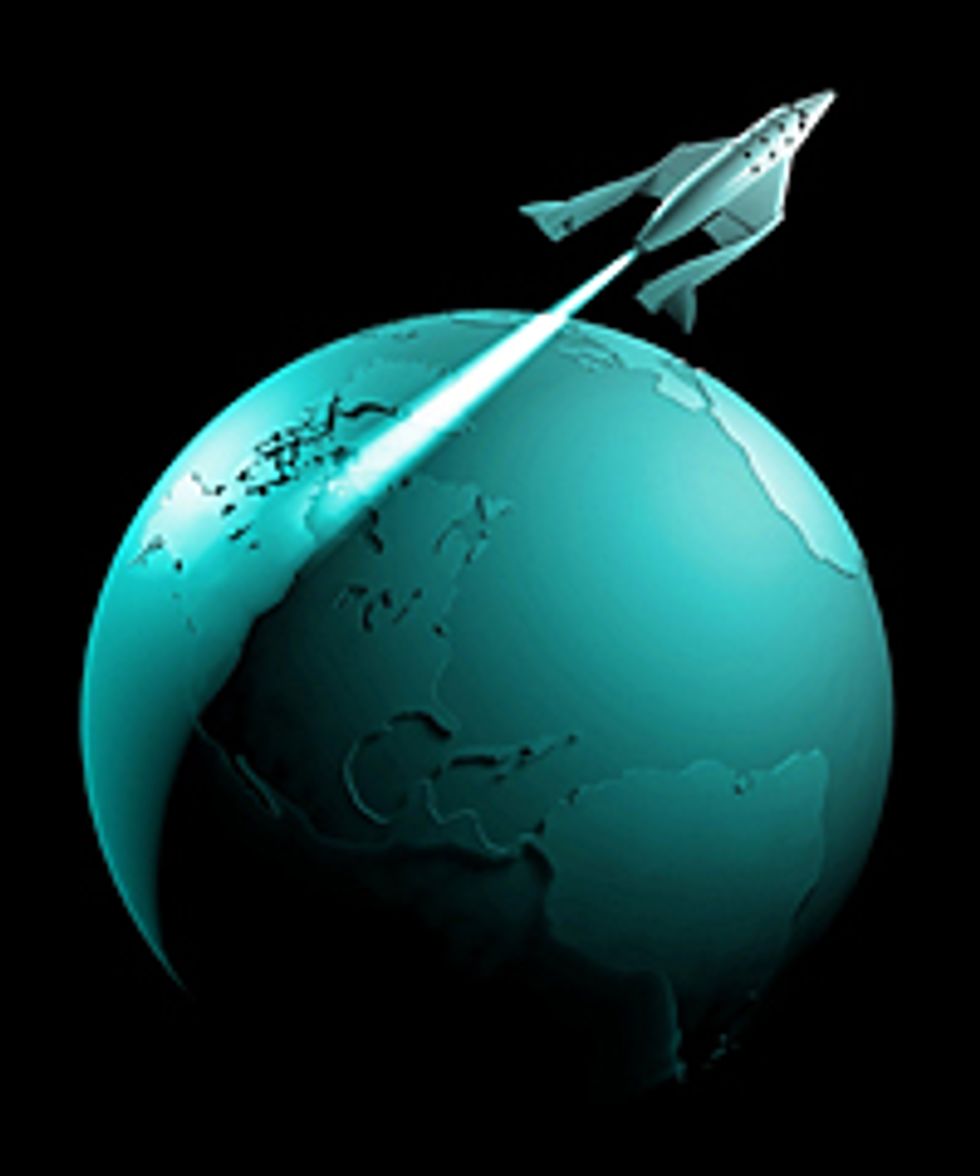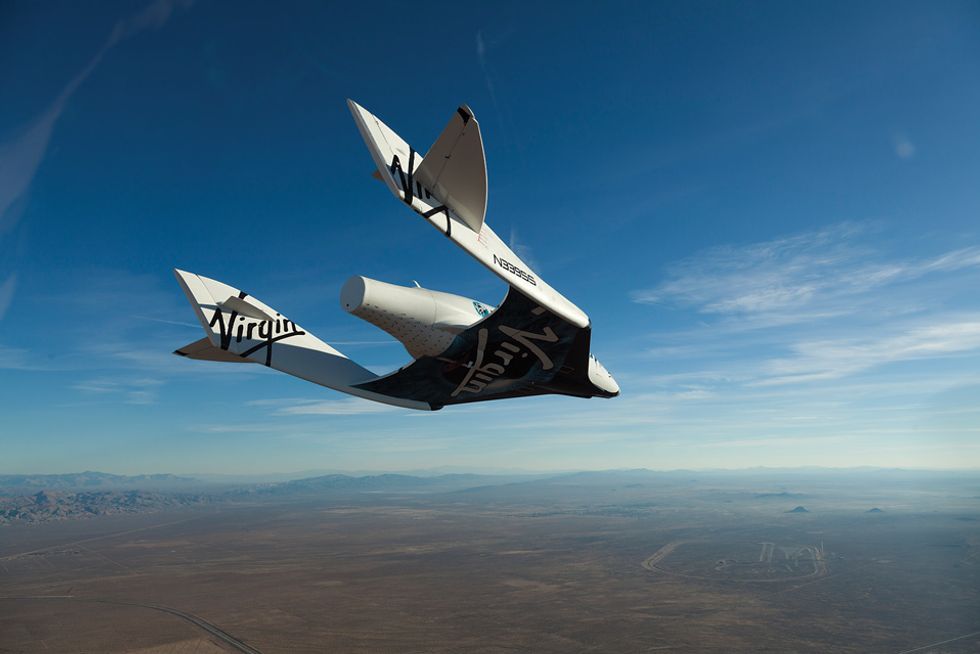Virgin Galactic Space Planes Should Launch This Year
$200 000 Buys You a Seat

In the high deserts of New Mexico, not far from the bison grazing on Ted Turner’s sprawling Armendaris ranch, lie some curiously otherworldly structures. The largest one presents a 15-meter-high wall of glass on one flank, although the rest of the building appears to have buried itself in the adjacent earth, as if it had crash-landed there. Just a couple of hundred meters away sits a low-slung dome with something that resembles a giant eye budding from the top. “It almost looks like a spaceship itself,” quips David Wilson, who handles media relations for the site.
The squat dome will house the operations center for this futuristic facility, called Spaceport America, the first spaceport ever built expressly for commercial use. And by the end of the year, Spaceport America should be home to the first-ever “spaceline”: Virgin Galactic, part of Sir Richard Branson’s London-based Virgin Group.
Once Virgin Galactic’s routine flights begin, ordinary people—at least, ordinary people with US $200 000 to spare—will be able to buy tickets into space. True, the company won’t take them into orbit, but it will fly them 100 kilometers (62 miles) above sea level to the Kármán line, which the Fédération Aéronautique Internationale defines as the edge of space.
To get there, they’ll have to have at least a dollop of the right stuff. The six passengers and two pilots will take off horizontally from the spaceport’s 3.7-kilometer-long runway in a space plane that will likely have the ambiance of a trendy business jet. This craft—dubbed SpaceShipTwo by the company that designed it, Mojave, Calif.–based Scaled Composites—will be slung beneath a double-fuselage carrier aircraft, WhiteKnightTwo, on takeoff and for the flight’s first couple of hours.
The real adventure begins after the two linked craft rise about 15 km (50 000 feet), at which point SpaceShipTwo will drop from its mounting, fire up its rocket motor, and go zooming upward into the heavens. Its passengers will then experience peak forces that are almost 4 g’s—four times normal gravity—more than what a ride up on the space shuttle gave its astronauts, although for passengers on SpaceShipTwo the push into their seats will last for just a minute or so. The feeling of acceleration will abruptly disappear when SpaceShipTwo’s rocket motor shuts down, as the craft coasts upward through a broad arc that will give its occupants about four minutes of free fall, or “weightlessness.”
Although Virgin’s plans do not include having flight attendants on board, the company is promising passengers that at this point of their flight they will be free to move about the cabin, as they say. (The pilots will no doubt joke with them about the dangers of unexpected turbulence.) After floating over to press their noses to the windows and spending some time enjoying a magnificent view of star-dappled blackness behind Earth’s curved horizon, these new astronauts will have to reseat themselves for the leg back home.
The wings of SpaceShipTwo are hinged, just like those of its predecessor, SpaceShipOne, which won the $10 million Ansari X Prize in 2004 by overtopping the Kármán line twice within a span of two weeks. Burt Rutan, founder of Scaled Composites and the designer of SpaceShipOne, realized that by rotating the aft section of its wings by about 65 degrees, the craft would be aerodynamically stable as it fell back into the atmosphere. Scaled Composites describes the resultant reentry as “hands‑off” or “care‑free.” But passengers probably won’t feel so carefree when they begin to experience the deceleration—up to 6 g’s worth at peak (although that level lasts only for seconds).
Can ordinary folks really handle such rigors without incident?
“Going to 6 g’s is a serious thing, but it’s a very trainable thing,” says George T. Whitesides, president and chief executive officer for Virgin Galactic. “We put 80 of our earliest customers through that exact g profile and the vast majority did fine.” Lynda Turley Garrett, a travel agent based in Saratoga, Calif., and an “accredited space agent” for Virgin Galactic, traveled to the National AeroSpace Training and Research Center in Southampton, Penn., where she rode a simulator-equipped centrifuge that duplicated the forces that Virgin’s passengers will be challenged by. Not only did she not black out, she found the experience thrilling. “It was 100 times better than any roller coaster I’ve ever been on,” she says.
More than 500 people have already signed up to get a taste of space with Virgin Galactic. Those who want to reserve the next available seat (as most have done) must pony up the full fare, so it’s no casual commitment. Whitesides expects that it’ll take his company more than a year from when commercial operations begin to find seats for all those who have put money down so far. And exactly when passengers will begin flying is unclear. But Branson has said that the first such flight, on which he and his two grown children will be passengers, should occur sometime this year.
It’s understandable that the timetable is still a bit vague. Ferrying ordinary people to the edge of space is, after all, not something anyone really knows how to do yet. While the U.S. Federal Aviation Administration is working hard to ensure all goes without incident, its role here is much more restricted than it is with airline travel. “The FAA is not certifying that the vehicle is safe,” says Whitesides, explaining that’s because there are no established procedures for safety certification when it comes to commercial space vehicles. “We’ll be operating in a somewhat unique regulatory regime based on informed consent,” says Whitesides. “The operator informs the customer [about the risks], and the customer makes the decision.”
How you judge the risks, though, isn’t so clear. The big question mark is SpaceShipTwo’s rocket motor. As with SpaceShipOne, that motor will be of hybrid type, using a solid fuel (a rubber-like polymer) and a gaseous oxidizer (nitrous oxide). “People have long recognized that hybrids have an inherent safety advantage,” says Brian Cantwell, a professor of aeronautics and astronautics at Stanford. That’s because even with a catastrophic failure of the motor, the fuel and oxidizer can’t mix easily. Hybrids have, however, been slow to catch on in the rocket business, because most of these designs provide underwhelming oomph. “The hybrid was perfect for SpaceShipOne because it did not require high performance,” says Cantwell.
Despite the inherent safety of hybrid rockets, things can—and have—gone badly wrong with them in the past. In 2007, the oxidizer tank being developed for SpaceShipTwo’s hybrid rocket motor exploded during a test of the motor’s oxidizer feed system, killing three and seriously injuring three others at Scaled Composites. Such an explosion was completely unexpected, given that nitrous oxide is normally considered quite stable—the very same substance (“laughing gas”) is used in countless dental offices. That a tank of this seemingly safe gas nevertheless exploded with great violence shows that hybrid rockets are not necessarily benign when they fail. “That’s probably the biggest safety concern,” says Cantwell. So it’s no wonder that Scaled Composites and Virgin Galactic have been proceeding most cautiously toward their goal since the fatal explosion five and a half years ago.
The pace of advance for Virgin Galactic is slower than it had been for SpaceShipOne, which took only three years to go from the start of full development to winning the Ansari X Prize. But that’s understandable, given the safety concerns that come with transporting passengers and the scale of things that need to be put in place to support a real spaceline. The Spaceship Company, a corporate entity created by Virgin Galactic and Scaled Composites in 2005 expressly to build these craft, is now working on a second SpaceShipTwo aircraft along with a second carrier. The plan is to build five spaceships and two carriers, which will be based at Spaceport America, meaning that operations must both scale up in size and move from California to New Mexico.
The end result should be something science-fiction writers have long dreamed of: regularly scheduled passenger flights into space. “We’re going to be shooting for once a week at the start,” says Whitesides. The technology is almost here to allow that, and space enthusiasts will no doubt celebrate the start of a new era when it comes, although few of them will have the means to celebrate it with a joyride into the beyond. And whether there will be a sustained demand for these $200 000 seats is anyone’s guess.
This article originally appeared in print as "To Infinity and Beyond: Tickets, Please!"


